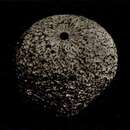fr
noms dans le fil d’Ariane


Cucumis humifructus, the aardvark cucumber or aardvark pumpkin, is a kind of cucumber (family Cucurbitaceae) from southern Africa, tropical Africa, and Madagascar which fruits underground. It is a prostrate vine up to seven meters (22 feet) in length. It is reliant on the aardvark to eat the fruit in order to spread and re-bury the seeds of the plant. The species was described in 1927, with the name spelled C. humofructus,[1] but this is corrected to C. humifructus following the International Code of Nomenclature for algae, fungi, and plants.[2]
Cucumis humifructus is thought to be the only Cucumis species having geocarpic (subterranean) fruit.[3] The vines of the plant initially develop their fruits above ground on stalks which then bend and push back under the ground.[4] The fruit then grows at a depth of between 150–300 millimetres (6–12 in). According to the PBS "Nature" television series, usually regarded as trustworthy, the cucumber is sometimes as deep as three feet (0.9 meters).[5] Most cucurbits have a single tendril at each node, but C. humifructus has 2 to 8,[6] to give it the leverage needed to bury the young fruit. It develops a tough skin which is water-resistant, and can remain intact for months without decay.[3] The plant grows as a trailing herb from 2–7 metres (7–23 ft) in tropical Africa and 0.5–2.5 metres (2–8 ft) in southern Africa.[7]
It is the only fruit (and only form of plant matter) eaten by aardvarks, which otherwise feed exclusively on ants and termites.[8] Aardvarks eat the fruit for its water content,[9] and propagate the seeds through their feces, which are then buried by the animals.[10] Due to the depth at which the fruits ripen, the seeds are unable to germinate without assistance, and C. humifructus is completely reliant on aardvarks to uncover their fruit.[3] This plant may be the reason why the aardvark is the only mammal feeding on ants and termites that has retained functional cheek teeth.[4]
It has a growing season of between three and four months, with its habitat being restricted to the savanna regions of tropical and southern Africa. It typically grows within the geographical range of aardvark burrows,[10] as the animals tend to defecate near their lairs.[9]
Cucumis humifructus, the aardvark cucumber or aardvark pumpkin, is a kind of cucumber (family Cucurbitaceae) from southern Africa, tropical Africa, and Madagascar which fruits underground. It is a prostrate vine up to seven meters (22 feet) in length. It is reliant on the aardvark to eat the fruit in order to spread and re-bury the seeds of the plant. The species was described in 1927, with the name spelled C. humofructus, but this is corrected to C. humifructus following the International Code of Nomenclature for algae, fungi, and plants.
В англійській мові називають «трубкозубів огірок» (англ. aardvark cucumber) чи «трубкозубова диня» (англ. aardvark pumpkin).
Плід рослини вперше було надіслано у 1910 році до Національного Гербарію. Проте проростити насіння не вдалося. У 1923 році рослину з описом надіслали в ботанічний сад К'ю, де не повірили, що плід розвивається під землею, а припустили, що місцеві заривають їх під землю з метою збереження. Вперше свідчення очевидців підтвердилися у лабораторних умовах, коли проросло насіння зібране банкіром та ботаніком Ернестом Едвардом Галпіном (Ernest Edward Galpin). У листі він написав, що ця рослина продукує плоди зовні схожі на бульбу, але всередині схожі на гарбуз. Хоча рослина загинула до того як плоди дозріли, науковці отримали достатньо доказів щоб підтвердити свідчення.
Дводольна рослина з малими різностатевими квітами. Має повзуче стебло від 2 до 7 метрів довжини з вусиками, за допомогою яких рослина чіпляється за різні об'єкти. Квітоноси короткі, міцні, з часом вигинаються та видовжуються у бік землі. Плід білувата кругла ягода, розміром в апельсин, містить численне біле гладке насіння у білій драглистій м’якоті.
Cucumis humifructus плодоносить під землею (геокарпія). Спочатку плід розвивається на поверхні, але потім квітоніжка вигинається і заштовхує його під землю на 150—300 мм. Шкірка плоду товста і водостійка, тому він може знаходитися під землею довго не гниючи. Рослина розвинула симбіоз з африканським трубкозубом, що шукає соковиті плоди у сухих сезон, поїдає і розносить насіння зі своїми фекаліями.
Розповсюдження Cucumis humifructus повністю залежиться від трубкозубів, оскільки плоди знаходяться дуже глибоко і насіння не може прорости самостійно.
Можливо саме через цю рослину у трубкозубів, що харчуються переважно мурахами та термітами, в ході еволюції збереглися бічні зуби.[1]
Зростає у Південній Африці та на Мадагаскарі.
Плід з вимірювальною рулеткою
Cucumis humofructus là một loài thực vật có hoa trong họ Cucurbitaceae. Loài này được Stent mô tả khoa học đầu tiên năm 1927.[1]
Cucumis humofructus là một loài thực vật có hoa trong họ Cucurbitaceae. Loài này được Stent mô tả khoa học đầu tiên năm 1927.